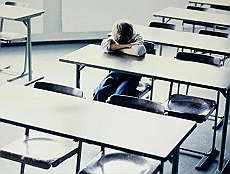High and dry. Is Italy failing its high-school students?
High and dry. Is Italy failing its high-school students?
(September 16, 2008)One third of the high-school students in Italy do not complete their first year. It’s the heavy price they pay for having to pick a specialty without adequate guidance
Starting high school is no picninc for anyone. At an age when most of us can’t even decide what to wear or what to have for breakfast in the morning, imagine having to decide what you want to be for the rest of your life.
That’s the kind of decision an Italian student and his or her parents must make when it’s time to choose a high school, and making the wrong choice could bear awful consequences.
“I attended the magistrale (a high school specializing in teacher training) because I thought I wanted to be a teacher” says Giovanna Cancelli, a medical student at the University of Rome, “but after the first year I realized that I did not like that school. I wanted to go to the liceo scientifico (a high school with a science specialization), but if I went there I would lose a year.”
An army of 600,000 Italian students are starting high school this week, with all the same dreams and anxieties of their peers everywhere else. Little they know that if they have made the wrong choice, they will pay a high price for it. Once entered high school, it is already too late to change your mind, and the nearly total lack of guidance only helps make this problem worse. Before he or she even learns how to drive, a student must decide whether they want to be a mechanic or an interpreter, an engineer or a chef. High school programs are in fact so specialized and different from one another, that it’s virtually impossible to transfer from one program to another.
The data speak loud and clearly about the effects of this gridlock. Over 30 percent of high-school freshmen will fail or drop out of school, and another 30 percent will pass the first year with unfinished courses, which they will have to complete over the summer.
“All these problems might be prevented if the students had the resources to make a sound choice.” says Roberta Iacobelli, a high-school teacher from Florence.
The most motivated students can increase their chances of completing high school by enrolling in remedial courses or tutoring sessions offered by some private schools, an option that requires an additional expense for their parents.
The criteria for choosing a high school are usually very random and instinctive, rather than well weighed. High schools with highly academic programs, such as the liceo classico (a high school with a focus on classical studies) have been traditionally associated with the better educated, thus usually wealthier social ranks. On the other hand, the high schools that offer clerical or vocational training programs are deemed as training camps for the workplace. These differences will also determine who will be more likely to succeed in college. In fact, students graduating from a liceo stand a much better chance of graduating from college than those coming from a technical or clerical institute.
In the absence of adequate guidance programs, the luckier students are those who can benefit from the advice given by university educated parents, or a generous teacher who takes the extra time to help them choose the right high-school specialty. For everyone else, it’s hit or miss. When an Italian teenager says that he or she hates school, they might have a good reason after all.
This work may not be reproduced, in whole or in part, without prior written permission.
Questo lavoro non può essere riprodotto, in tutto o in parte, senza permesso scritto.




